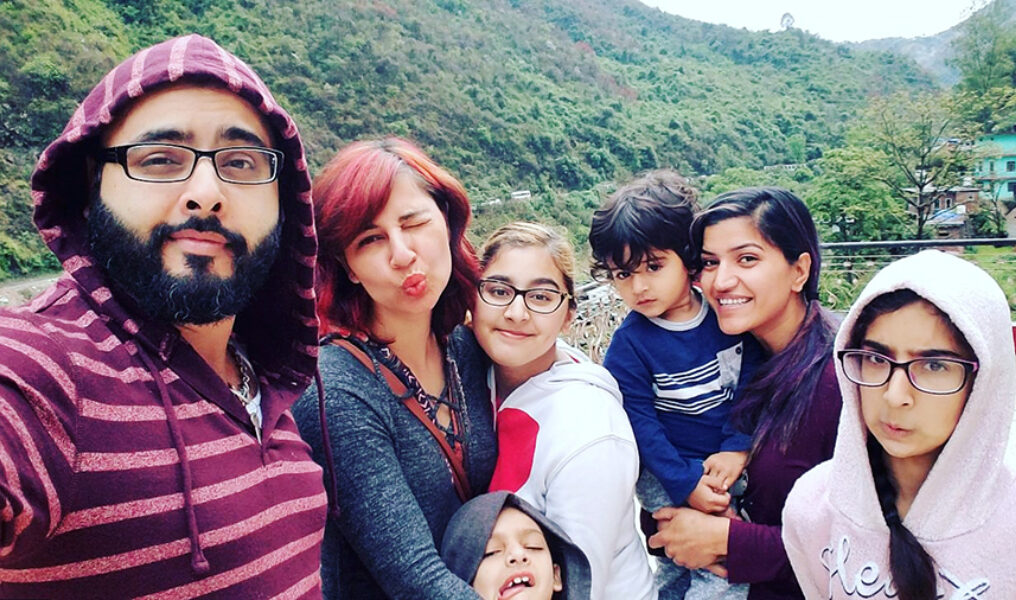Raising Kids in a Big, Happy, Poly Family
The unique normalness of families with three or more parents

By now, same sex parents are relatively commonplace, but what about when those partnerships expand to include a third or fourth partner? Turns out, these arrangements aren’t particularly rare, and in the day-to-day, polyamorous families are simply... families.
Journie, 40, grew up in a polyamorous household in northern Michigan, with their dad, biological mom, “Momma Jeanne,” who was their dad’s wife, and four siblings (Journie asked that we use only their first name and wanted to keep their specific location private). Though Journie’s biological mother was often in and out of their life due to mental health and drug issues, all the parents raised the children together.
Each parent regularly had other partners as well, some longer term than others, and their mom also had a long term girlfriend, Terri, who stepped into a motherly role for them after their mom died.
“I always had a big family and people there for me for every step in life. Even though, technically, all my siblings are half siblings or not biologically related at all, we've never thought of ourselves as anything less than siblings,” they said. “And even after I lost both of my biological parents as a young adult, I still had my Momma Jeanne and my Terri as parental figures in my life.” Journie notes that Terri continued many of their mom’s birthday/holiday traditions for many years until she passed away a few years ago, as well.
Today, Journie is supporting their polyamorous partners in raising their own children, too.
Polyamory, or ethical non-monogamy, can take different forms, and is typically a relationship in which people have multiple partners or relationships at the same time. Like many monogamous couples, polyamorous partners may also choose to become parents, sometimes resulting in a blended family of half and step siblings who are raised together.
While parental roles can be well-defined, often, parents in polyamorous relationships adjust to meet the fluctuating needs of an extended poly family at different points. Journie, who helps raise their polyamorous partner’s child, says that they have stepped up to fill the role of a parent by staying at their house and getting them to and from school while their parents were unavailable, cooking meals, and taking them to doctors appointments, helping them learn to drive or providing emotional support during tough times. To the kids, Journie is their stepmom.
Meanwhile, Sunny Singh, Speetie Singh and Piddu Kaur, a polyamorous family from Indiana who are raising four children together, approach parental responsibilities more fluidly. “I think we never made any rules. Each of us handles whatever we like to do,” says Speeti. “We are kind of winging it as we go. We are all mom and dad to all the kids,” adds Sunny.
It helps that the three often tend to be on the same page about how they want to raise the children and are pretty like-minded. But differences arise at times. “The kids enjoy that,” says Sunny. “If one of us says no to something, they get to try two more times.” However, the adults often work together to find common ground.
Stephanie M. Sullivan, a licensed marriage and family therapist who has her own private practice in Michigan and works primarily with LGBTQ+ individuals and polyamorous folks, emphaises the need for good communication in resolving conflict but also in just understanding the role each parent plays. “I think polyamorous relationships do add a lot more dynamics, a lot more potential for conflict. But it doesn't have to end in conflict,” she says.
She explains that it comes down to how people are communicating, how they are talking about their parenting styles, and how they come to conclusions. How do they want to present as a team to their child? Having very honest conversations about what roles each partner has in the children's lives is essential.
If two people are nesting partners, and they each have external relationships, it needs to be clear how involved external partners will be in the children’s lives — each situation can be very unique in this respect. “So it really comes down to just communicating, making sure everyone's on board and understands what their different roles are,” she says. “And if they're not happy in their role, communicating about how to change that,” Sullivan adds.
Ultimately, relationship experts say, the impact of a polyamorous relationship on children is directly related to people's parenting rather than their polyamorous status. How people are parenting, how they're communicating, how they're modeling to their children, has a larger impact on their children than whether they have two parents or more.
For Journie, who refers to her partner’s children as her “podlings,” she has a rule about not getting involved in resolving conflicts between her podling and their parents. “I don't get involved in resolving their conflict but will often give feedback later,” she says. “My podling has come and stayed with me a few times throughout the years when there was conflict at home with their parents; my partners trusted that I would care for them as best as I could.”
For the children in the house, having multiple people to rely on who can model healthy relationships can be a big benefit. And for Speeti, Sunny, and Piddu’s four children, having two mothers and a father is the most normal thing in the world. “Our kids have managed to handle it well, and they actually brag about it. The oldest one, she reframes the whole thing and makes it so that it's something to be proud of. She's got a great handle on this,” says Sunny.
“I think what they mostly met up with was a lot of curiosity. A little bit from the other kids, but the other kids would normalize it pretty quick. It would be more from other parents who would be curious and ask their kids to find out for them,” he adds. However, they consider themselves blessed that they have really not faced much harassment or bullying. Their children have accepted their family as normal, and this is the only way that the younger ones have known things to be.
Polyamorous partnerships can also help children understand the value of family. Journie has always had a big family, and people who were there for them every step of the way. “When I talk to people about my family and how I was raised, many people are shocked at first, but I don't think there's anything shocking about it; my parents were part of the ‘free love movement,’ and it wasn't deviant at all,” they say. “It was like being raised in a household with extended family members — they just happened to share a bedroom instead of being aunts, uncles, grandparents and so on.” =
In the end, Journie believes their podling is learning valuable relationship skills and how to negotiate relationship agreements while advocating for their needs. What’s most important, Journie says, is that they are being raised in a home with lots of love and have learned that love can be expressed in many ways, two achievements that bring them pride every day.









